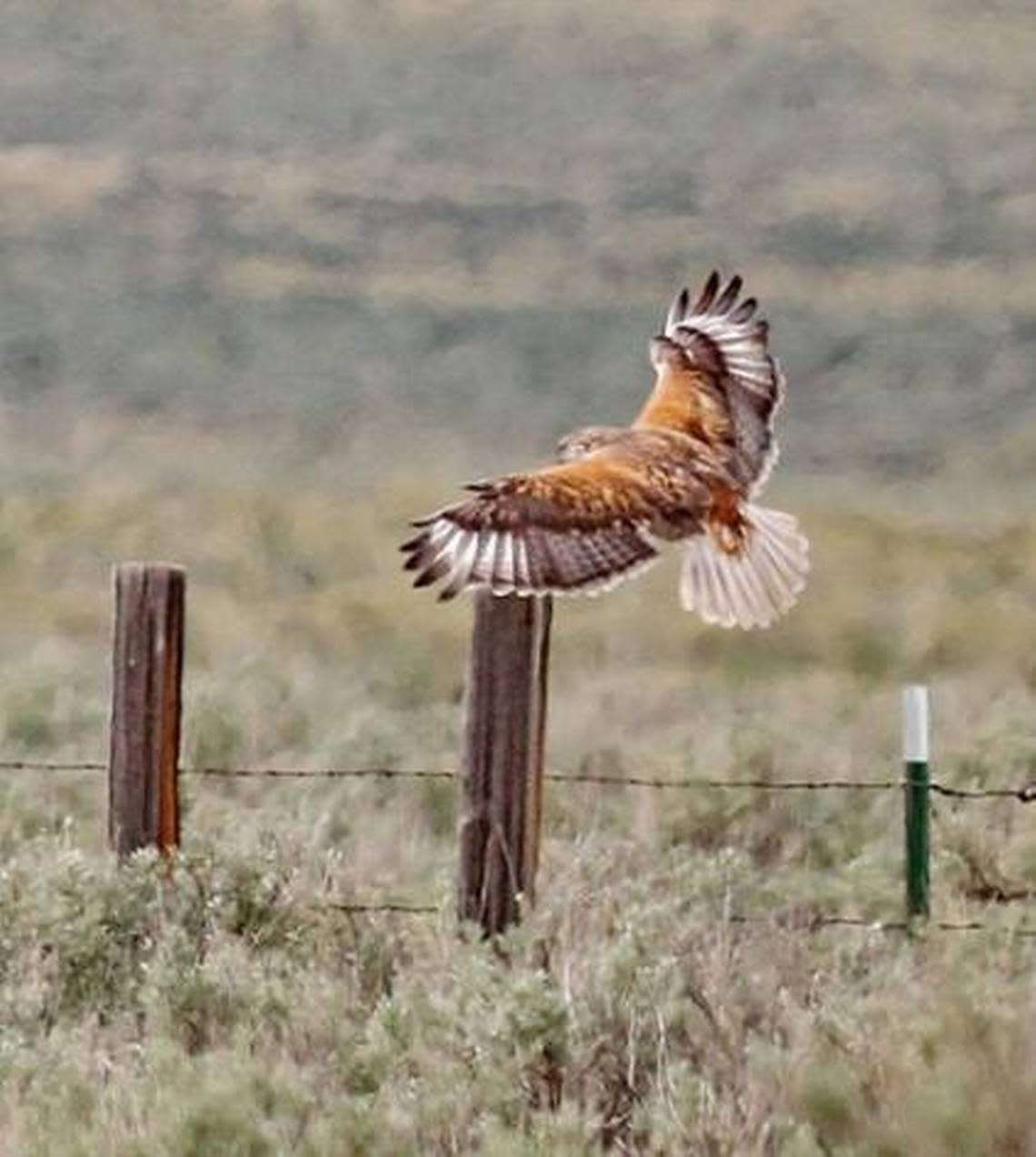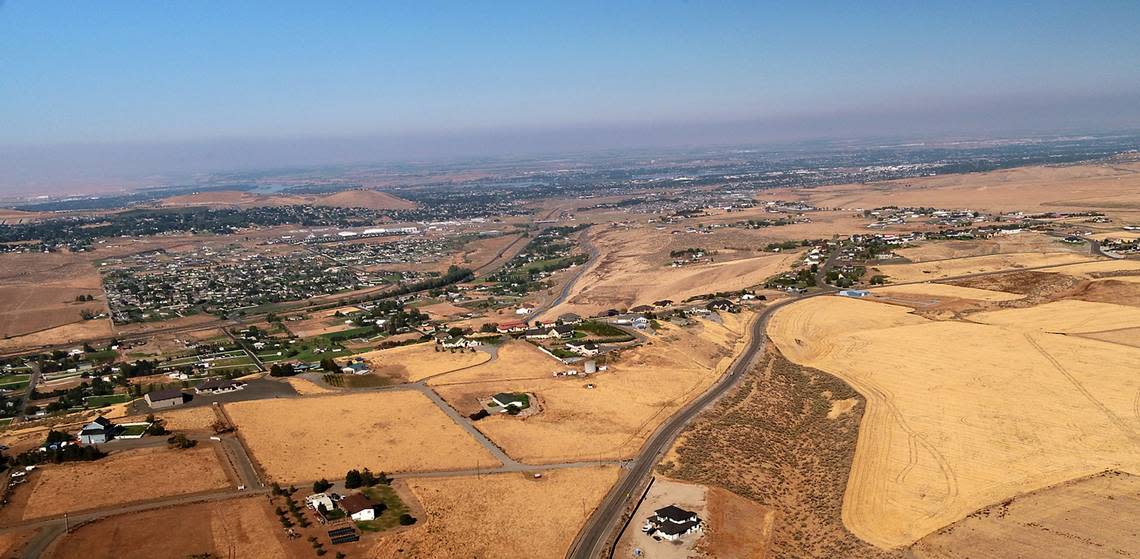WA Gov. Inslee rejects plan to limit turbines on proposed huge Tri-Cities wind farm
Washington Gov. Jay Inslee has directed the state’s energy facility siting council to recommend allowing more turbines to be built at the Horse Heaven Wind farm project just south of the Tri-Cities.
The Washington state Energy Facility Site Evaluation Council, EFSEC, recommended to the governor in late April after three years of study and discussion that where the turbines could be built should be limited, which could reduce their number as originally proposed by about half.
The project, which would be the largest wind turbine project in the state, was initially proposed to stretch for 24 miles along the ridgeline of the Horse Heaven Hills south of Kennewick, dominating the southern skyline view from much of the Tri-Cities.
Scout Clean Energy proposed the Horse Heaven Clean Energy Center be built with up to 222 turbines about 500 feet tall or 141 turbines about 670 feet tall, plus solar arrays and battery storage.
Inslee sent a letter to the council Thursday telling it to consider mitigation measures for the project that would be more specifically tailored to concerns raised about the project rather than significantly limiting the project areas where turbines could be built as it had recommended.
That could allow the wind farm to meet or be close to the initial energy production in the initial project proposal, he said.
“I strongly encourage the council to return to me their approval of this project application that appropriately prioritizes the state’s pressing clean energy needs,” Inslee wrote.
Restrictions proposed by the council on where turbines could be built would protect some of the view from south of Finley along the hill tops to south of Benton City, Native American cultural resources and ferruginous hawks, which are considered a threatened species in Washington state.

Inslee had a choice of rejecting the application, approving it with restrictions proposed by the council or asking EFSEC to reconsider aspects of the proposal.
He has asked the council to respond within 90 days to his request to reconsider the restrictions it developed for the project. Then the governor must either approve or reject the project.
Scout Clean Energy was pleased with the governor’s actions.
“We appreciate Governor Inslee’s leadership and the efforts being made by all parties to strike the appropriate balance between mitigating potential impacts and maximizing the project’s ability to generate urgently needed clean energy,” said Michael Rucker, founder and chief executive of Scott Clean Energy.
Ferruginous hawks
EFSEC voted to recommend prohibiting turbines within a two-mile buffer area around historically documented ferruginous hawk nests. The hawks are a state endangered species.
Proposed restrictions on the project could increase the ability of the hawks to return to certain areas of historic usage, according to the EFSEC report for the governor.
But Inslee told EFSEC Thursday that wildlife mitigation measures recommended by EFSEC were “overbroad.”
Disturbance from agricultural and residential land use has already caused a significant decline in the ferruginous hawk population on the proposed project site, he said.

More than 60% of the nesting territories of the ferruginous hawk in Washington state is concentrated in Franklin and Benton counties, which is considered the core breeding range in the state, according to the Washington state Department of Fish and Wildlife’s 2021 status review of the hawk.
It said that an average of 55 breeding pairs per year nested in the state between 1992 and 1995.
But no ferruginous hawk has been seen nesting in the proposed wind farm project area in five years, the governor said.
Inslee questioned “whether the ferruginous hawks will return given the considerable, permanent changes to their habitat.”
He directed EFSEC to consider other mitigation methods that would not reduce the clean energy project’s generation capacity.
He proposed EFSEC recommend no turbines in sage shrub steppe and rabbitbrush acreage in the project area.
Turbine construction or use elsewhere in the project area could be curtailed when ferruginous hawks were seen or a nest was active within two miles, particularly during breed and nesting season from late March to late July.
He favors a Scout Clean Energy proposal that it seek a conservation easement of 779 acres of land within the northeast corner of the project.
Scout could also buy or lease similar natural habitat outside the project’s boundary that is still within ferruginous hawk nesting territory, the governor proposed.
Ferruginous hawk deaths due to turbine strikes also should be monitored throughout the life of the project. Technology such as IdentiFlight, which detects birds also might be considered if economically feasible, the governor said.
Cultural resources
The Yakama Nation had asked that turbines, solar arrays and infrastructure be prohibited on significantly more land than EFSEC recommended to the governor to protect cultural resources.
But the governor said that mitigation that EFSEC recommended should instead be focused on specific and narrowly tailored approaches to allow as much electricity generation as possible.
Scout Clean Energy should be required to attempt to require access agreements on the land it leases to allow the Yakama Nation to occasionally visit culturally important sites, the governor said.
Access should be explored for the Yakamas beyond the length of the energy project, including purchasing culturally important land and transferring ownership to the Yakama Nation, he said.
Signs could be put up acknowledging the tribal cultural resources within the project area, he said.
Tri-Cities WA view
Inslee said that he respects the opinion of those who don’t like seeing turbines on the landscape but “all sides would agree that continued and reliable electricity service is imperative.”
“Given the state’s clean energy needs and requirements, adopting a zero-tolerance policy to visual impacts is inconsistent with state statues,” he said.

The turbines would not loom over anyone’s home, he said.
But turbines on the southern horizon have met with significant opposition in the Tri-Cities, in part because it would industrialize the southern skyline in a community that prides itself on the colorful sunsets of its desert vistas.
Along with the nearby and smaller Nine Canyon wind farm, just over 100,000 residents of Benton County would live within six miles of a turbine as the project was originally proposed, according to Tri-Cities CARES, a group opposing the wind farm as too close to the Tri-Cities.
That’s five times more than the estimated 20,000 who live within six miles of a wind farm across the rest of Washington state, according to the group.
The EFSEC recommendation sent to the governor called for eliminating turbines from much, but not all, of the project area closest to the Horse Heaven ridgeline.

They would be in an area with multiple impacts that could include the view, Native American cultural resources and ferruginous hawk nesting areas.
“I find that this approach of eliminating a large swath of the proposed turbine locations to achieve a generalized reduction in impacts across a number of categories takes an overly broad approach to addressing the very different types of impacts at issue,” Inslee told EFSEC.
It results in a “dramatic reduction” in the project and should be replaced with operational limitations that allow for building the vast majority of the project as originally proposed, he said.
Significant adverse impacts may be accepted where they cannot be reasonably mitigated, he said.
The proposed project could produce up to 1,150 megawatts of electricity, or about 5% of the new electricity generation needed in Washington in the next decade, according to the governor’s letter. By 2050 electricity load growth is expected to increase to 92% above 2020 levels.
Without a rapid build out of new clean energy transmission, the dependability of the electricity grid is at risk, the governor said.
Scout Clean Energy is not required to sell the electricity to users in Washington state.
“We must come to grips with the fact that we will need to adapt and accept relatively moderate changes to our physical landscape, in order to ensure continued, reliable electricity service,” he said.
However, the Benton PUD has issued a policy paper saying that the continued push for more wind projects by developers and many elected officials will do nothing to alleviate the looming risk of power grid blackouts in the Pacific Northwest.
